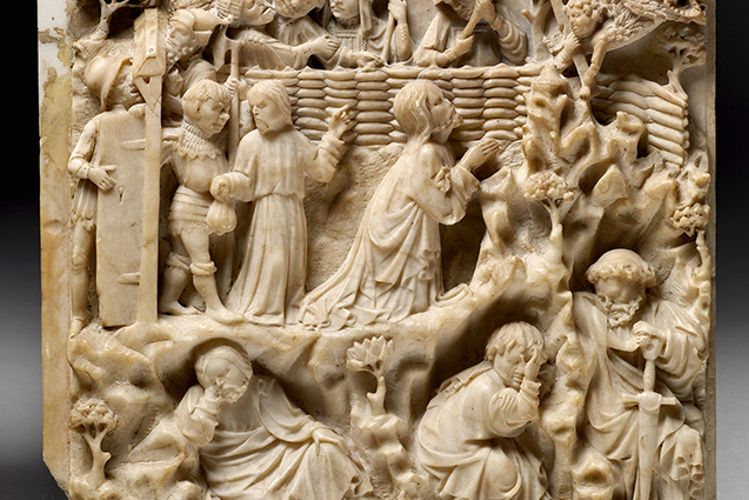ART WORLD NEWS
Glam rock: alabaster was not medieval England’s ‘poor man’s marble’ new book finds
[ad_1]
The Agony in the Garden (around 1430-40) by the Rimini Master, one of the pre-eminent continental sculptors of alabaster carving
© Antje Voigt/SBM/Ashmolean Museum, University of Oxford
For many anglophone readers, alabaster—a crystalline form of gypsum—is synonymous with English late medieval sculpture, a misapprehension reinforced by the entry on the subject in the otherwise magisterial Grove Dictionary of Art, which concentrates almost entirely on the English output. The production of the English alabaster sculptors, active between the mid-14th and mid-16th centuries, is represented by the many tombs and even more numerous relief panels on, and from, altarpieces (more than 2,400 and growing), and it is the instantly recognisable style of the latter, together with their conservative and uniform iconographic traits, which characterise the works.
There is now a substantial literature, going back to the end of the 19th century, on English medieval alabasters, and this has shown no sign of slowing. Many of the earlier writings—and some of the more recent offerings—were of an antiquarian and often parochial nature, effectively treating the English alabasters as an isolated phenomenon and failing to locate them in their pan-European context. It is one of the many virtues of Kim Woods’s new book that we are now able to view the English examples alongside those of the same material in France, the Burgundian Netherlands and Spain. Many, such as the Dijon and Brou tombs, will be known to medieval art aficionados, but there is much else that will inform and delight by its unfamiliarity and high quality.
Woods sets out to correct the view that alabaster was a “poor man’s marble”. She demonstrates first that there was often no distinction drawn between the materials, and that the terminology used in documents was in any case interchangeable, flexible and occasionally imprecise, but then goes on to illustrate alabaster’s very special qualities and its status among sculptors and patrons. In nine long chapters, the author leads us through the main issues connected with a single-material study, never forgetting the necessity of setting the alabaster carvings in a broad cultural context.
Rather than attempting a complete survey—an impossible task—she illuminates the subject with case studies and carefully selected paradigms of the principal types, elucidating what it is about alabaster that sets it apart. Some of this builds on her previous publications, as with the excellent pages on the so-called Master of Rimini (not an Italian, despite the name) and his workshop, the core of whose work has long been dated to 1420-35, and whom Woods tentatively identifies as Gilles de Backere of Bruges.
Woods is on firmer ground with the tombs executed by Gil de Siloé at Miraflores and elsewhere in Burgos, and one of the great values of the book for an English audience will be the emphasis on the less well-known Spanish tombs and altarpieces, especially those in Aragon, Navarre and Catalonia. The surpassing quality of the 15th-century altarpieces in Zaragoza and Vic will be evident from the fine photographs, but there is no substitute for a face-to-face experience, and nobody who has spent time in front of Pere Joan’s sublime reliefs dedicated to the story of St Thecla on the high altarpiece of Tarragona cathedral (which Woods sadly omits to cover in detail) can fail to agree that they have been unjustly neglected in the history of medieval sculpture.
Further sections focus on different projects involving alabaster, including the patronage of Edward III at Gloucester and Westminster, the tomb of Charles the Noble in Pamplona cathedral, and the splendid tombs in St Nicolas-de-Tolentin in Brou. These are followed by two more general chapters on funerary sculpture, touching on various types common to the different countries and regions, and including what Woods calls the “bespoke” tombs of René of Anjou, those in Sigüenza and elsewhere, and that of Engelbrecht of Nassau in Breda. The volume concludes with two chapters on altarpieces and other genres of sculpture, both in the public and private spheres.
Woods has the advantage of a background in, and a profound knowledge of, Netherlandish late medieval sculpted altarpiece production, mostly in polychrome wood. Her mastery of sources is evident in her ability to navigate the more arcane documents for the commissioning and acquisition of tombs and altarpieces—charting the journey from quarry to owner —and this sits very satisfactorily alongside her sensitivity to the sculptures themselves. She understands how they were made, how they were finished for the market, and is aware of how their appearance has sometimes changed quite radically.
The book is also a pleasure to use, whether dipping in for a specific reference or reading from cover to cover, with beautiful photographs (many taken by Woods) and a crisp, unfussy layout. We have had to wait a long time for such an intelligent and well-researched overview of European late medieval alabaster sculpture, but have been rewarded with a splendid and multi-faceted volume that will both stimulate the student and inform the specialist.
• Paul Williamson is Keeper Emeritus and Honorary Senior Research Fellow at the Victoria and Albert Museum. His most recent book is The Wyvern Collection: Medieval and Renaissance Sculpture and Metalwork (2018)
[ad_2]
Source link













